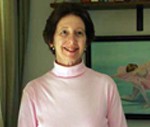A Spoonful of Sugar: A Nanny’s Story, by Brenda Ashford, Doubleday 2013 (and co-writer Kate Thompson)
By Sheila Orysiek

SAN DIEGO — Fairy tales usually begin with “Once upon a time” and end with “they lived happily ever after.” But is that true? No, of course not – that’s why they are called “fairy tales,” silly.
What really happens is, after a day spent wearing a long white dress, a tiara topped veil, sitting beside a dream catcher of a handsome Prince, as his gorgeous white horse prances up a winding path to a shining white castle on top of a verdant mountain, what actually happens (after a nine month delay) is the happy couple are confronted by a small, wriggly, nascent, sentient, non-verbal human being screaming for attention. What to do?
Well, if your bank account is well endowed, you call the prestigious Norland College in the UK and asks for a Norland Nanny to come to the rescue. If you are fortunate you will score well in the interview with her which is just as important as how well she impresses you. Now you are in the same league as royal parents around the world as well as countless billionaires and other fortunate inhabitants of fairy tale land.
Wearing the distinctive light brown uniform, the Norland Nanny is the product of an intense three year course of study in child care in all its various phases and skills. The Norland College was established in 1892, with the express purpose of training women to be knowledgeable, dependable, professional child care specialists. In the early days that included many hours spent learning how to make a pram (baby carriage) shine even on a rainy day.
In case you are wondering, the Nanny is not “in service” – a servant. She does not eat below stairs (a la “Upstairs/Downstairs” or “Downton Abbey”). She is to be addressed as “Nurse Brenda (if that is her first name) or “Nanny Brenda.” Her life is centered around the nursery (or two: day nursery/night nursery) and she is the reigning authority within those hallowed halls, which may include an assistant or two, but only she is addressed by the honorific of “Nurse/Nanny.”
Author Brenda Ashford, as she writes this book, is 92 years of age and has spent 62 years caring for the children of many households of every degree of social standing. With the birth of her younger brother, she early discovered her intense emotional response to children and her need to be a part of their nature and nurture. As a graduate of Norland, plus the experience of being raised in a loving home, she had much to give. In the normal course of events, a Norland Nanny would expect to spend her career within the rather small world of a select few families who could afford her services.
Because of World War II, Nanny Brenda’s experience expanded well beyond the enclosed walls of moneyed society. One of Britain’s first responses to finding itself at war with Germany, was to evacuate young children from the large cities. This included orphanages as well as those brought up among the docks living in extreme urban poverty. Thus children who had rarely seen a tree, were transported to the country estates of the very wealthy who had turned over their property to house them.
Nanny Brenda found herself as a young Norland graduate in charge of dozens of children with whom the staff could barely communicate; their speech patterns being so very different. Everything about them was different. Some children had never been bathed. In fact, when their parents discovered they were being bathed, reacted with anger and sewed the children into their clothes to prevent it. Many had no concept of discipline. Some reacted with fear, others with bravado.
Among these young British evacuees were approximately ten thousand Jewish children who fortunately had been able to escape from the continent. Nanny Brenda tells of one fragile little girl who arrived unable to communicate in English, having known nothing but fear in her life. She sat huddled in corners hugging a Teddy Bear, shivering with terror at the onset of a storm, and feeling utterly abandoned. Nanny Brenda spent many hours trying to reach this child which she eventually did.
Sprinkled through the book are snippets of “Nanny’s Wisdom,” as well as a pudding recipe or two. She tells of her own emotional turmoil as a woman who loves children but gives up the prospect of ever being a wife and mother. This is reinforced by two traumatic romantic disappointments. The description of the training at Norland College is interesting as are the descriptions of the equipment and norms of another time.
Occasionally, the reader senses the presence of another pen – voice – in the text. This seems puzzling as only Ashford is listed as the author on the title page. However, it is only on the very last page – as a note – that a co-writer is named. This second voice, I believe, should have been listed on the title page.
*
Orysiek is a freelance writer who specializes in the arts and literature. She may be contacted via sheila.orysiek@sdjewishworld.com. Comments intended for publication in the space below must be accompanied by the letter writer’s first and last name and by his/ her city and state of residence (city and country for those outside the U.S.)